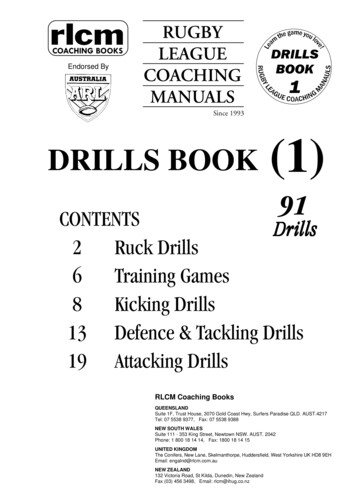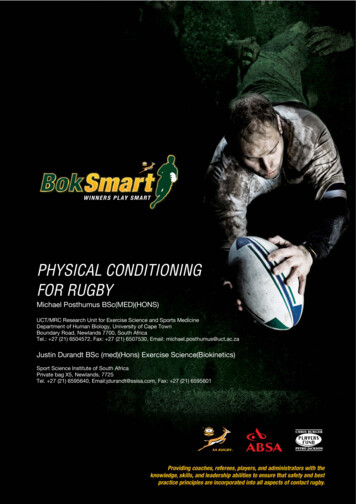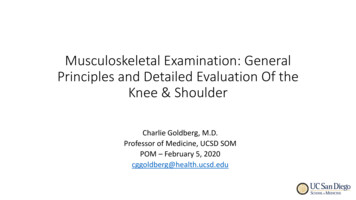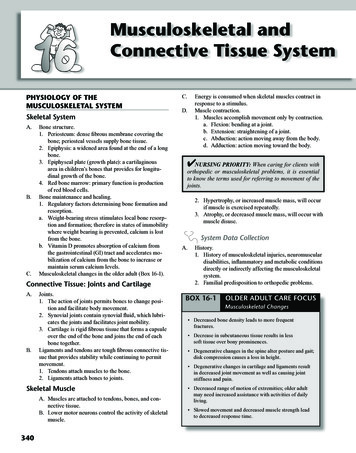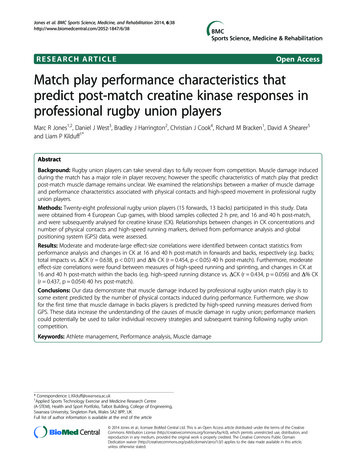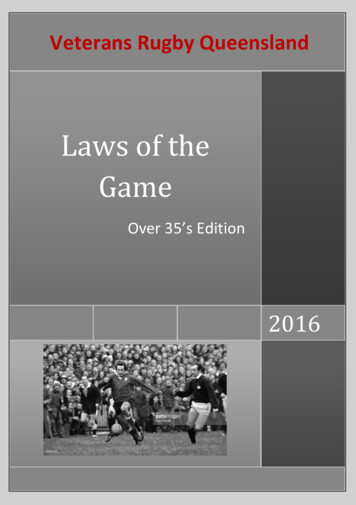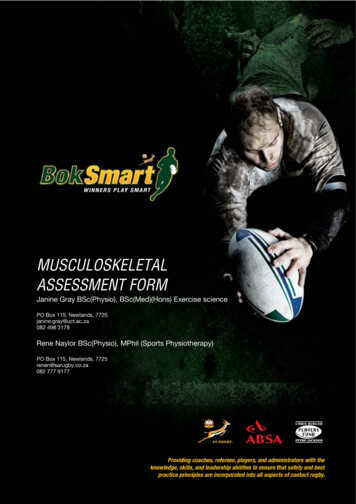
Transcription
Musculoskeletal Assessment FormPage HeadingMAIN HEADINGSub HeadingsBody CopyBody Copy BoldBody Copy Bold ItalicBody Copy Normal Italic Bullets1. MCL Posterior medial capsulStyle Body for tablesSTYLE HEADING FOR TABLESMUSCULOSKELETALASSESSMENT FORMJanine Gray BSc(Physio), BSc(Med)(Hons) Exercise sciencePO Box 115, Newlands, 7725janine.gray@uct.ac.za082 498 3178Rene Naylor BSc(Physio), MPhil (Sports Physiotherapy)PO Box 115, Newlands, 7725renen@sarugby.co.za082 777 91770Copyright BokSmart 2009
Musculoskeletal Assessment FormINTRODUCTIONThe purpose of musculoskeletal screening for athletes prior to participation in sport is an attempt toidentify possible intrinsic risk factors for specific athletes, participating in specific sports, highlighting riskfactors for specific injuries(1;25;31). The ultimate aim of the risk identification is to include appropriatepreventative strategies for individuals or sporting populations at risk for a specific injury in order todecrease the occurrence of injury (1;24).A number of problems exist when establishing a musculoskeletal screening. Firstly, many of the clinicaltests described have not been validated and the reliability is unknown. Secondly, the tests need to besimple so that they can be easily administered in a variety of locations. Thirdly, the tests need to beinexpensive to administer, requiring as little equipment as possible. This increases the compliance of theprofessionals required to complete the tests. Furthermore it increases the number of subjects that can betested which improves the relevance and meaning of risk factors identified within particular groups.In an attempt to address a number of the problems highlighted above the following steps were taken.Firstly, wherever possible, tests were included which have been found to have good inter-tester andintra-tester reliability, unless otherwise indicated. Secondly, equipment needed for the protocol has beenkept to a minimum. Thirdly, the number of tests have been reduced to improve compliance in completingthe musculoskeletal screening.The structure of the musculoskeletal has a large focus on the lower limb injury. The literature has shownthat the lower limb is injured at a greater frequency (46-68% of total body injuries)(2;4;7;8). Of the 10 mostfrequently described injuries sustained by England during the rugby World Cup (7) occurred in the lowerlimb (6). As such these injuries receive more focus in the screening of the athlete.The musculoskeletal form consists of two parts; the questionnaire and the musculoskeletal screening.The questionnaire is the most subjective area of the screening process but provides much informationwhich is relevant to injury risk. When evaluating the risk of hamstring injury increasing age and a previousinjury (within the last 12 months) were found to increase the risk of a hamstring injury(25;28). A study toevaluate the validity of a 12 month injury recall found that football players were able to recall if they hadexperienced an injury – “Yes” or “No” within the last few months(27). These players could recall very littleof the diagnosis. Therefore, if the injury status is being related to a particular outcome measure they arelikely to be accurate. If more detail than this is requested the validity of the questioning may becompromised. As such the following questionnaire is limited in the detail required. The informationobtained in the questionnaire includes questions regarding training, injury, protective equipment, inaccordance with recommendations in the current literature (25;28).1Copyright BokSmart 2009
Musculoskeletal Assessment FormThe procedure for each test has been described in detail. As there are a number of different protocolsused to describe a single test it is imperative that the procedure described in the manual be used toensure the reliability of the test.Where possible, normative data are provided; in some cases these data have not been obtained fromrugby players. However, this problem will be addressed as the information on rugby playersaccumulates.The following document has been compiled using similar protocols to those used in Australia and NewZealand. Researchers from these countries have been able to identify meaningful risk factors for anumber of injuries as a result of the information collected from the questionnaires. This has enabled themto establish and implement rehabilitation or prehabilitation strategies to combat and reduce the risk ofinjury. The expected outcome of this document is similar, i.e.:1. To provide South African medical professionals with a screening protocol which containsreliable, and where possible valid clinical tests.2. To feedback risk factor findings with regards to specific injury profiles.QUESTIONNAIREThe questionnaire was developed to retrieve the following information: the subject’s age, playing history,level of experience and position played. Further information included training during the season, thepreseason and the off season. The players warm up and cool down habits and the protective equipmentused. Finally an injury recall was done. These items have been found to be reliable (28) and the injury recallover a 12 month period has been found to be valid (27). The validity has been established for relating injurystatus to a particular outcome or risk factor. Details on diagnosis and particulars pertaining to the injuryhave limited accuracy, as described earlier.The questionnaire is self explanatory requiring mostly YES/NO or numerical answers. However, due tothe poor recall ability of players it is important that the injury recall component of the questionnaire becompleted by the physiotherapist or medical professional with the player. This will increase the accuracyof the questionnaire.2Copyright BokSmart 2009
Musculoskeletal Assessment FormPOSTURAL ASSESSMENTDefinitionsPostural assessment is a very subjective component of the screening process. However, correlations doexist between injury and posture (12;32).Equipment requiredNo specific equipment is required. However, if the subjects are able to stand against a grid placed on thewall it may increase the accuracy of the assessment.ProcedureThe subject stands barefooted in a relaxed posture wearing shorts or swimming trunks. They need tostand a sufficient distance away to allow the person doing the rating to adequately view the posture. Thedifferent components of the postural assessment are viewed anteriorly, posteriorly and from the side(Figure 1, 2, 3). The following postural assessment was done:a)Shoulder symmetry: Are the shoulders level when viewed from the front or the back?b) Roundedness of shoulders: Observed from the front and side. Are the shoulders held in internalrotation with anterior translation of the humeral head?c)Thoracic spine alignment: This is observed from the side. Does the subject have an increased ordecreased thoracic kyphosis?d) Spinal curvature: This is observed from behind. Does the subject have a spinal scoliosis?e)Lumbar lordosis. This is observed from the side. Does the subject have an increased lumbarlordosis or a flattened lumbar spine?f)Hip symmetry: Observed from the front or back. Are the hips level?g)Knee Hyperextension: This is observed from the side. Are the knees held in hyperextension?Rating: Table 1 provides details on the rating system for the postural assessment3Copyright BokSmart 2009
Musculoskeletal Assessment FormTable 1. The rating scale for postural assessment as found in the musculoskeletal formRating scalePosturecomponentsNormalMild essNormalScoliosis convex leftScoliosis convex rightIncreasedkyphosis/lordosisNormalDecreased ssHip symmetrySpinal curvatureThoracickyphosisLumbar lordosisNormalKnees hyperextendedKneehyperextensionReliabilityThe reliability of a limited postural assessment was found to have acceptable Test-Retest reliability in astudy which evaluated 10 components of posture (32).Figure 1. Posture viewed anteriorly4Figure 2. Posture viewed from the sideFigure 3.3 Posture viewed posteriorlyCopyright BokSmart 2009
Musculoskeletal Assessment FormFLEXIBILITY TESTSACTIVE KNEE EXTENSION TESTDefinitionThis test assesses the hamstring muscle length and the range of active knee extension in the position ofhip flexion (18;19;26)Equipment requirementsA support is required to maintain the position of 90 hip flexion. This support can be in the form of awooden frame which is placed against the posterior thigh. A goniometer is required. A flexiometer canalso be used to record the range.ProcedureThe subject lies supine with the leg to be tested in a flexed position. The therapist then places thesupport against the posterior thigh with the hip in a 90 of flexion. Alternatively an assistant can maintainthe position of the thigh. The subject then actively extends the knee while keeping the foot relaxed. Whenfinal extension is reached the therapist supports the calf and measures the degree of knee extensionrelative to the vertical (Figure 2). If the therapist uses a goniometer the arms should be aligned as follows:The fulcrum is placed of the lateral epicondyle of the femur.The stationary arm of the goniometer is aligned with the lateral midline of the thigh with the greatertrochanter as the reference point (This line should be perpendicular to the horizontal/plinth).The moving arm is aligned with the lateral midline of the fibula, using the lateral malleolus as the referencepoint.ScoringThe knee extension measurement is recorded in degrees (x), to the nearest degree. The final angle iscalculated as 90 - x. If the subject is able to fully extend the knee, then the therapists flexes the hip 30 past the vertical. The hip extension angle obtained is then subtracted from 120 (120 -x).ReliabilityAn intra class correlation coefficient (ICC) of r 0.93 (95% CI: 0.80-0.98) was obtained for inter-raterreliability. Intra-rater reliability was excellent with ICC figures of 0.96 and 0.94was confirmed by a further study(26). The intra-rater reliability(18;19). The same study demonstrated a poorer inter-rater reliability. Thereliability for this test was found to be 0.79 in a group of children age 10-13 and would therefore be agood test for this age group (50).5Copyright BokSmart 2009
Musculoskeletal Assessment FormNormative dataTable 2. demonstrates the hamstring flexibility relative to risk of hamstring injury(28). A hamstring flexibilityrecorded as an angle of less than 20º, although not significant, would appear to be most beneficial.Table 2: Active knee extension range (º) relative to hamstring injury.Active kneeextensionNumber of subjects% players who sustained hamstringinjury 20º21-30º 30º8185569.917.714.2Figure 4: Position of measurement for the Active Knee Extension testPASSIVE STRAIGHT LEG RAISEDefinitionThe straight leg raise test (SLR test) is used to measure the flexibility of the hamstrings (34;43;59).Equipment requiredPlinth, pelvic belt and goniometerProcedureThe subject is in a supine position on a plinth. The pelvis is placed in a posteriorly tilted position to allowthe lumbar spine to come into contact with the plinth. This position can be maintained using a beltaround the anterior superior iliac spines and the plinth but is not essential (29) (Figure 5).EMG electrodes connected to a recorder can be placed on the hamstring muscle to measure electricalactivity in the muscle as it is stretched. The electrodes should be placed in series with their centres 3 cmapart, between the center of the innervation zone of the biceps femoris and its distal tendon. All threeelectrodes should be placed on a line joining the origin and insertion of the muscle. The procedure ofusing electrodes does not have to be used.6Copyright BokSmart 2009
Musculoskeletal Assessment FormThe ankle joint is maintained in a neutral position. A flexible goniometer (South African Sport ScienceInstitute of South Africa, Newlands, Cape Town, South Africa). A normal goniometer can be secured tothe lateral side of the fibula to measure the angle of hip flexion. The subject’s leg is lifted into hip flexionwith maintenance of the knee extension. The degree of hip flexion is measured at either of these 4 endpoints: (i) as the tester feels the knee starting to flex; (ii) as the subject reports a feeling of markeddiscomfort, but no pain; (iii) when the tester determines the end feel of movement, and (iv) as a spike inthe EMG activity from the electrodes is displayed on the monitor. The subject’s leg is then returned toneutral.ScoringThe degree of hip flexion measured at either of the 4 points described in the procedure of the straight legraise test is used as an outcome variable. A small degree of hip flexion would indicate less flexibility.ReliabilityThe mean correlation coefficient between tests conducted on day 1 and day 3 for the different variablesof the straight leg raise test was 0.97, indicating excellent reliability(43). A study that examined theinfluence of hip position on straight leg raise test found that hip position affected SLR relative tohorizontal (p 0.0001) and pelvis relative to horizontal ( p 0.0001) with an increase in measurement withthe opposite hip flexed (11). A study compared 4 clinical tests designed to measure hamstring musclelength and found there was no significant difference between angles of passive SLR with pelvis strapped(61 6.7º) and SLR with low back flat (62 6.2º). The similar angles of SLR with pelvis strapped and withthe low back flat and their significant relationship (r 0.70, p 0.001) indicated the different testprocedures had minimal influence on the test results (29).Normative Data (adapted from(36;59)).These studies indicated that less than 90 on a straight leg raise test was considered a risk factor forprimary or first time hamstring strains.7Copyright BokSmart 2009
Musculoskeletal Assessment FormWitvrouw 2003 (59) (n 146)Jonhagen 1994 (36) (n 11)Hamstring Range90 90 Study DesignProspective.Retrospective.SexMaleMaleAge (years)Unknown22.0 yearsPopulationProfessional soccer playersSprintersMeasurementGoniometric measure. of hamstring,quadriceps, adductorsCalfSLRInjury definitionClinical diagnosisClinical diagnosisNo. of ham. Injuries3111Figure 5. Position of measurement for the Passive Straight Leg raise.MODIFIED THOMAS TESTDefinitionThe Modified Thomas test is used to assess the flexibility of the hip flexors (iliopsoas) and the kneeextensors (quadriceps). In addition the test provides a measure of hip abduction (18;19;26;31).Equipment requiredA plinth and goniometer are required for this test.ProcedureThe procedure has been described in a number of texts(18;19;26;31).The subject sits on the edge of the endof the plinth. The subject then rolls back on the plinth and pulls up both knees to the chest. This ensuresthat a flattened lumbar spine is achieved with a posteriorly rotated pelvis. The subject holds the8Copyright BokSmart 2009
Musculoskeletal Assessment Formcontralateral leg in flexion against the chest while lowering the test leg towards the floor. The lower leg isallowed to hang freely so that the end position is obtained with gravity alone.Measurement of the iliopsoas: The angle of hip flexion is used to determine the iliopsoas length(Figure 6). The goniometer is positioned as follows:a)The axis of the goniometer is aligned with the greater trochanter.b) The stationary arm is aligned with the lateral midline of the pelvis (the horizontal).c)The moving arm is aligned with the midline of the femur using the lateral epicondyle as areference point.Measurement of the quadriceps: The angle of knee flexion is used to determine the length of thequadriceps (Figure 7). The goniometer is positioned as follows.d) The axis of the goniometer is placed over the lateral epicondyle of the femur.e)The stationary arm is aligned with the lateral midline of the thigh (line of the femur).f)The movable arm is aligned with the fibula using the lateral malleolus as a reference point.ScoringBoth measurements are taken to the closest degree (º).ReliabilityThe ICC’s for this flexibility test were between 0.91-0.94 (31).Normative dataThe mean flexibility for the iliopsoas and quadriceps is presented in table 3.Table 3. The mean flexibility for the iliopsoas and quadriceps. The standard deviations are shown inbrackets (adapted from (31))Joint angles gTennisAverage-10.7 (6.0)-11.8 (4.9)-14.2 (4.7)-10.9 (6.0)-11.9 (5.6)56.0 (8.4)53.5 (6.6)50.6 (7.9)49.9 (5.6)52.5 (7.6)9Copyright BokSmart 2009
Musculoskeletal Assessment FormFigure 6. Position of measurement for the Modified Thomas test (hip flexors)Figure 7. Position of measurement for the Modified Thomas test (knee extensors)ACTIVE HIP INTERNAL AND EXTERNAL RANGE OF MOVEMENTDefinitionThis test assesses the active range of hip rotation in a neutral position(18;19)hip internal rotation is an indicator of inadequate gluteus medius control. It is proposed that increased(46).Equipment requirementsA plinth and a goniometer are required for this test.ProcedureThis test is described with a player both in a supine position and prone with the hip in neutral. The intrarater reliability of hip rotation assessed in either position is very good, but the inter-rater reliability wasbetter measuring hip range of movement in supine(18;19;26). For this reason the test will be described insupine.10Copyright BokSmart 2009
Musculoskeletal Assessment FormThe subject lies supine on a plinth with the hip in neutral and the lower leg hanging freely over the edgeof the plinth. The opposite leg is flexed at the hip and knee with the foot on the plinth. The subject isasked to internally rotate the hip to maximum without movement at the pelvis (Figure 8). The goniometeris positioned as follows:a)The axis of the goniometer is placed over the mid-point of the patella.b) The fixed arm is held vertically.c)The movable arm is placed along the length of the patellaThis is repeated for hip external rotation (Figure 9).ScoringThe measurement is recorded to the nearest degree ( ).ReliabilityThe inter-rater reliability for the assessment of hip rotation range in supine is 0.94 (Internal rotation) and0.88 (External rotation)(26). The intra-tester reliability was also excellent with an ICC between 0.83 - 0.92for internal rotation and 0.83 – 0.90 for external rotation. These findings were further supported by Pua etal.(48). The inter-observer reliability of this measurement in the prone position was poor and is thereforediscouraged (18;19)Normative dataNormative data for hip internal rotation and external rotation is presented for Tennis players and baseballpitchers (Table 4)(21;35). In a group of soccer players, the injured players (adductor strain) had a decreasein the cumulative hip rotation range of movement (45º) versus the uninjured players (54º) (35). In a group ofcricketers it was found that bowlers with a hip internal range of motion less than 30º had a decreasedrisk of injury (18;19). The relationship between injury and range in rugby players needs further investigation.Table 4: Normative hip internal and external rotation range of movement. (Values are expressed as mean standard deviation).Parameter and groupDominant hipNon Dominant hipHip internal rotation27 1026 8Hip external rotation37 936 9Hip internal rotation37 1035 11Hip external rotation36 935 9Tennis playersBaseball pitchers11Copyright BokSmart 2009
Musculoskeletal Assessment FormFigure 8: Position of measurement for active hip internal rotation range of movement.Figure 9: Position of measurement for active hip external rotation range of movementANKLE DORSIFLEXION LUNGEDefinitionThis test is used to assess the dorsiflexion range of movement at the ankle joint (3;18;19;25)Equipment requiredThis procedure needs to be done against a wall. A standard tape measure (cm) is needed.ProcedureSubjects are required to position their foot so that a line drawn through the heel and the big toe arealigned on a tape measure on the floor. A vertical line is drawn on the wall in line with the tape measure.12Copyright BokSmart 2009
Musculoskeletal Assessment FormThe subject is instructed to lunge forward so that their knee touches this vertical line. The leg not beingtested can rest on the floor. Subjects are able to hold onto the wall for support. The heel is required toremain in contact with the floor at all times (Figure 10). Three attempts are allowed. The maximumdistance from the wall to the tip of the big toe is recorded.The therapist conducting the test may hold the subject’s heel to ensure contact is maintained with thefloor. Pronation and supination of the front foot was not limited.ScoreThe distance is measured in centimeters (cm) to the closest 0.1 cm.ReliabilityThe inter-rater reliability for the distance measured for the ankle dorsiflexion lunge was R 0.99 (95%CL: 0.97-0.99)(3). The intra-rater reliability of the measurement was excellent (ICC between 0.98-0.99).These findings were further supported by a further reliability study (18;19).Normative dataThe mean range of ankle dorsiflexion in the reliability study was 13.9 3.8 cm (3). Studies evaluating therisk of injury using the ankle dorsiflexion lunge suggested that a measure less than 10 cm increased theplayer’s risk of sustaining a hamstring injury(25). This however, needs to be verified in further studies.Other studies showed that cricket fast bowlers had a significantly decreased risk of injury if the range wasgreater than 14 cm (18;19)Figure 10. Position of measurement of the ankle dorsiflexion lunge13Copyright BokSmart 2009
Musculoskeletal Assessment FormSIT AND REACH TESTDefinitionThe sit and reach test is commonly used to measure combined spinal and hamstring muscle flexibility.Equipment requirementsA sit and reach box is required. This is a box which has a perpendicular surface against which the feetcan be placed. The top of the box has an overhanging piece which extends over the subject’s toestowards the subject. A ruler is fixed on top of the sit-reach box, such that the zero line of the rulercoincided with the vertical line of the feet(25;26). Older studies have positioned the ruler at 23 or 26 cm.Therefore, it is important to consider this when normative data from studies using this type of box areused. If an old sit and reach box is used simply subtract 23 or 26 cm to obtain the final score.ProcedureThe subject sits with the soles of his feet against a sit-reach box with knees fully extended. The subject isinstructed to flex maximally at both hips and lower back. One hand should be held directly on the top ofthe other - this position is held for 1 second (Figure 11).ScoringThe furthermost point reached by the subject’s middle finger is measured off the ruler to the nearest 0.5cm.ReliabilityJohnson and Nelson (1979) have documented the reliability of the test. However, a subsequent studysupported the validity of the sit and reach test as a measure of hamstring flexibility, but not lower backflexion range of motion(41). The intra-rater reliability is r 0.99 (95% ICC: 0.98-1.00) and 0.98 (95% ICC:0.94-0.99)(26). The inter-rater reliability for sit and reach is 0.97 (95% CI ICC: 0.91-0.99) and 0.98 (95%CI: 0.97, 0.99)(26;51).Figure 11.11 Position of measurement for the sit and reach test14Copyright BokSmart 2009
Musculoskeletal Assessment FormNormative dataIn a study investigating the risk factors of hamstring injuries in elite Australian football, an increased sitand reach score was associated with a slighter higher relative risk of injury than a reduced sit and reach(25)(Table 5). Although this was not significant it does indicate that the previous sit and reach scoreswhich implied the greater the sit and reach score the less likely the player is to be injured, needs to be reevaluated.Table 5. The sit and reach scores and relative hamstring injury risk (adapted Gabbe et al (25))Sit and reachNumber of subjectsRelative risk of hamstringinjury 10cm6212.901-10cm9514.74 0cm6412.50LUMBAR SPINE EXTENSION RANGE OF MOVEMENTDefinitionThis test is used to assess the range of movement of the lumbar spine extension (26).Equipment requiredA tape measure.ProcedureThe subject stands with feet shoulder width apart. The subject is instructed to fully extend his spinekeeping his knees straight at all times. At the same time the subject is required to reach as far down theback of the leg as possible. The distance from the tip of the left middle finger to the middle of thepopliteal crease is measured using a tape measure (Figure 12). If there is pain at any point during the testthis must be recorded.ScoreThe measurement is recorded to the closest 0.1 cm. If the subject’s finger reaches above the poplitealcrease the measurement is recorded as a positive ( ), and if the finger reaches below the poplitealcrease it is denoted with a negative sign (-).ReliabilityThe inter-rater reliability was R 0.95 (95% CI ICC: 0.85-0.99). The intra-rater reliability was 0.86 and0.89 respectively (26)15Copyright BokSmart 2009
Musculoskeletal Assessment FormNormative dataThis method of evaluating lumbar extension has not been reported extensively. Normative data needs tobe collated for rugby union players. The mean range for this test obtained in the reliability study was 9.7 4.5 cm.Figure 12. The position of measurement for lumbar spine extension range of movementFORWARD FLEXION OF THE LUMBAR SPINEDefinitionThis test is undertaken to assess the forward flexion range of the lumbar spine. This test is described asa routine test when evaluating the lumbar spine of athletes (10). In addition, this tests aims to identify areasof the thoracic and lumbar spine which do not follow the natural curve of the back and represent areas ofstiffness. These represent areas where there is limited segmental stability. As such this test assists inidentifying areas with a dysfunction of the deep trunk stabilizers.Equipment requiredTape measure is required.ProcedureThe subject is asked to stand with his legs shoulder width apart. He is then instructed to flex his lumbarspine forward getting the upper body relaxed with arms outstretched towards the floor (Figure 13). Thesubject’s knees must remain extended at all times. The distance from the floor to the tip of the middlefinger is measured. If a subject is able to touch the floor with any part of the hand the subject is given a16Copyright BokSmart 2009
Musculoskeletal Assessment Formscore of 0. The tester then views the curvature of the thoracolumbar spine to identify areas of stiffness(Figure 14).ScoringThe amount of forward flexion is recorded to the closest 0.1 cm. The tester must mark “is there stiffness:Yes/No” and then identify the vertebral levels which are stiff by ticking the relevant blocks provided on thescreening form (Table 6).Table 6. Table for Forward flexion in the musculoskeletal screening form.YesNoLevel of segmental stiffnessLumbar stiffness (L1-5)Lower thoracic stiffness (T7- T12)ReliabilityThe authors have not been able to find any studies which have validated this test. However, the clinicalrelevance of this test in assessing the segmental control of the thoracolumbar spine is deemedsignificant. It is acknowledged that this test may be compromised by the lack of clinical experience of thephysiotherapist.Normative dataNo normative data exists for a test of this nature. The clinical relevance of the stiff segments is ofimportance. Scores of “normal” or “ideal” would represent a spine which has a constant curve free of anystiff segments.Figure 13. The position of measurement for forward lumbar flexion17Copyright BokSmart 2009
Musculoskeletal Assessment FormFigure 14: Identifying areas of stiffness in the lumbar spine during forward flexion (L2-4)COMBINED ELEVATION TESTDefinitionThe combined elevation test assesses combined thoracic extension (strength and range of motion),shoulder girdle flexion and scapula retraction (18;19).Equipment requiredA tape measure.ProcedureThe subject lies prone on the floor with both arms outstretched above his head. The elbows areextended, thumbs locked and palms facing the floor. The subject is instructed to keep his feet, chin,chest and hips on the ground at all times. The subject is instructed to breath in, hold his breath and thenraise both arms off the floor as high as possible maintaining extension of the elbow. The measurement istaken from the base of the metacarpal of the thumb to the floor in a perpendicular line (Figure 15).ScoreThe measurement is taken to the closest 0.1 cm.ReliabilityThe inter-rater reliability was good with an ICC of R 0.87 (95% CI: 0.63-0.97). The intra-rater reliabilityis 0.97 (95% CI: 0.88-0.99) (18;19).Normative dataNo normative data exist for rugby players for this test.18Copyright BokSmart 2009
Musculoskeletal Assessment FormFigure 15. The position of measurement for the combined elevation testSHOULDER EXTERNAL/INTERNAL ROTATIONDefinitionShoulder internal rotation and external rotation measurements are representative of posterior and anteriorcapsular tightness respectively(42;45;56). Athletes trained for sports which involve activities and movementsabove their heads demonstrate an adaptive increase in shoulder external range of motion with aconcurrent decrease in internal range of motion(5;9;17). As a result of these findings a combined range ofmotion is assessed to determine the relevance of capsular tightness in the shoulder.Equipment requiredA plinth and goniometer is required. An assistant increases the accuracy of the measurement.ProcedureThe subject lies supine on a plinth and the tester moves the humerus to 90º abduction in the coronalplane(42). The scapula is stabilized by the tester’s hand while the shoulder is moved into i
POSTURAL ASSESSMENT Definitions Postural assessment is a very subjective component of the screening process. However, correlations do exist between injury and posture (12;32). Equipment required No specific equipment is required. However, if the subjects are able to stand against a grid p

